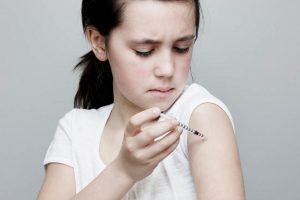November is Diabetes Awareness Month
When most people think of diabetes, they tend to think that it has to do with eating too much sugar or being overweight. For children diagnosed with Type 1 (or Juvenile) Diabetes, this is not the case.
What is Type 1 Diabetes?
Type 1 Diabetes affects about 3 million Americans, and each year 15,000 more children and adults are diagnosed. So, what exactly is Type 1 Diabetes? This form of diabetes is an autoimmune disease, where the body stops producing insulin, and it is not caused by diet or lifestyle.
Insulin is what keeps our blood sugar in a normal range. When we eat, food becomes sugar in our blood. This sugar (glucose) is our primary source of energy. Insulin is then released into the bloodstream to turn the glucose into energy.
In diabetes, the pancreas doesn’t make enough insulin or the body can’t respond normally to the insulin that is made. This causes the glucose level in the blood to rise. Without insulin, sugar stays in the bloodstream. Over time, high blood sugars can cause significant damage to the body. On the other end of the spectrum, when blood sugar is really low, it can cause loss of consciousness and even death.
So, children who have diabetes are dependent on insulin in order to keep their blood sugars at a normal level. They typically have to test their blood sugars many times a day in order to make sure they are at an appropriate level. Every time a child with Type 1 diabetes eats a snack or meal, they will need to take insulin. The amount of insulin is determined by the child’s doctor and diabetes educators. Children receive insulin one of three ways:
- Insulin vial and syringe – insulin dosage is drawn up into syringe and injected into skin (usually arm, stomach or thigh)

- Insulin pen – insulin dosage is ‘dialed’ up in the insulin pen and injected into skin (usually arm, stomach or thigh)

- Insulin pump – these small, computerized devices allow for a continuous flow of insulin to be released the body. The pumps have a small, flexible tube (called a catheter), which is inserted under the skin of the abdomen and taped into place.

Blood sugar is checked with a Glucose Meter. A child will prick the tip of one of their fingers and draw blood onto a disposable test strip. The meter will then tell the amount of glucose in the bloodstream.

A normal blood sugar level is between 70 and 120 mg/dL. When a child is below 70, they may be feeling symptoms of low blood sugar.
Signs of Low Blood Sugar (under 70) include:
- Sweating
- Nervousness, shakiness, and weakness.
- Extreme hunger and slight nausea.
- Dizziness and headache.
- Blurred vision.
- A fast heartbeat and feeling anxious.
Some young children are able to recognize when they are feeling low and alert an adult. If you notice a child with diabetes who seems to be acting like she/he has any of the above symptoms, it is important to get this child some sort of fast-acting glucose. Typically, when someone has low blood sugar, they can drink juice, eat cake icing, or special glucose tablets made for diabetics with low blood sugar.

Signs of High Blood Sugar (over 180) include:
- Increased thirst
- Headaches
- Difficulty concentrating
- Blurred vision
- Frequent urination
- Fatigue (weak, tired feeling)
- Weight loss

How to care for a child with diabetes
Though diabetes can be a scary diagnosis, it simply involves some lifestyle changes. If you have a child with diabetes in your care, it is important to not make them feel any differently. Often, these children still eat candy and sweets from time to time, and they lead normal lives.
Each child with diabetes has a diet plan, set up with their dietitian. Knowing this plan is important. Dietitians do tend to work their diet around school schedules, so most likely the child will be eating the same snacks and meals at the same time as the other children. Be sure to meet with parents so that you are on the same page. Parents should provide you with a child’s testing kit, insulin supplies, and emergency foods for low blood sugars. When in doubt, ask questions. At this young age, a child has most likely been recently diagnosed and the child and parents are still learning how to live with diabetes. With your patience and understanding, you can help children with diabetes enjoy a normal day.
For more information and to learn more about Type 1 Diabetes, visit: http://www.jdrf.org/.
Amazon Picks and Resources:



